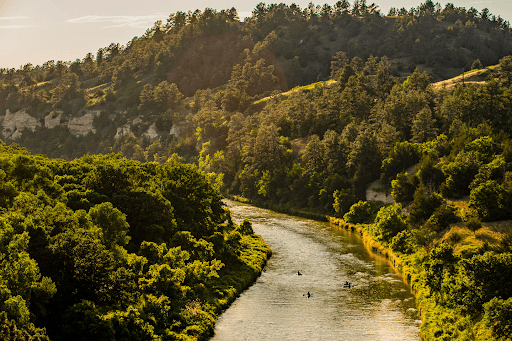
Rivers and streams play an essential role in Nebraska, benefiting both the environment and its people. These waterways provide vital habitats for various plant, fish, and wildlife species, including those that are endangered or protected. They also contribute to the state's economy and enhance the quality of life for Nebraskans. Many residents enjoy spending time by these rivers, whether it's fishing, kayaking, canoeing, or simply taking in the natural beauty around them.
March 14, 2025 marks International Day of Action for Rivers, a time to unite in support of rivers and the communities that defend them. This year’s theme is focused on “Our Rivers, Our Future. Together” highlighting the vital role rivers play in sustaining our planet’s health and all life on Earth.
Rivers are vital to civilization and life on Earth, yet freshwater ecosystems are the most endangered. Since 1970, freshwater species have declined by 83%, twice the rate of terrestrial and marine species. The conservation of rivers in Nebraska and globally is crucial.
Rivers of Nebraska
Nebraska is home to approximately 79,056 miles of rivers, with 197 miles designated as wild and scenic, making up about 1% of the state's total river miles. Despite being landlocked, Nebraska is considered a "water lover's paradise" because it boasts a vast network of rivers, with more miles of navigable waterways than most other states.
The three main rivers in Nebraska are the Niobrara River located in Northern Nebraska, the Missouri River along the eastern boundary of the state, and the Platte River which runs across the southern half of the state.
The Niobrara River:
Culture
- The Niobrara River and Verdigre Creek have attracted prehistoric and historic use, offering diverse vegetation and animal resources for wild food gathering, hunting, trapping, and fishing.
- The area was home to Ponca farmers, and the Ponca Agency and cemetery represent the ongoing cultural connection of the Ponca community.
Ecology
- The Niobrara River supports diverse habitats, with backwaters, sandbars, and wetlands that host endangered species like the interior least tern and pallid sturgeon.
- The middle Niobrara River Valley is a biological crossroads with six distinct ecological communities, from pine forests to tallgrass prairie, supporting a rich variety of species.
- The river is a significant habitat for multiple species, serving as an important area for hybridization and evolution.
Geology
- The Niobrara Valley’s geology includes exposed formations like the Ash Hollow, Valentine, and Rosebud, along with waterfalls unique to the Great Plains.
- The valley's cliffs showcase geological formations ranging from 6 million to 76 million years old, offering a visible history of the region's past.
Paleontology
- Fossils, first discovered in the 1800s, are abundant in the Valentine and Ash Hollow Formations, with discoveries of prehistoric mammals, camels, mastodons, and mammoths.
- Fossil quarries, particularly on private land, contain significant evidence of ancient species, making it a critical paleontological site.
Recreation
- The Niobrara River attracts tens of thousands of visitors annually for canoeing, tubing, and hiking, offering both serene and challenging water experiences.
- The Fort Niobrara National Wildlife Refuge provides a quieter float, while further downstream, visitors encounter sandbars and a lively summer atmosphere.
Scenery
- The Niobrara River winds through a steep-walled valley with views of forests, prairies, and marshes, complemented by waterfalls and high cliffs.
- The landscape is dynamic, with seasonal changes, diverse habitats, and abundant wildlife adding vibrancy to the scenery.
The Missouri River:
Culture:
- Missouri River has been a key trade and travel route from Paleo-Indians to modern European settlers.
- Historic sites like Ponca Agency and Spirit Mound are listed in the National Register of Historic Places.
Ecology:
- The river features diverse ecosystems, including wetlands, cottonwood forests, and native prairies.
- Home to many mammal and bird species, including rare woodland songbirds and bald eagles.
Fish:
- The Missouri River provides high-quality, shallow-water habitats for native fish species- supporting one of the highest diversities of mussels.
Geology:
- The Missouri River is unique due to its position between glaciated terrain and ancient sea sediments.
- Notable geologic features include chalk bluffs, marine fossils, and the Ionia Volcano.
Recreation:
- Offers a variety of activities like boating, birdwatching, fishing, hiking, and hunting.
- Popular for both motorized and non-motorized activities.
Scenery:
- A 100-mile stretch of natural beauty with shifting sandbars, chalkstone bluffs, and rural landscapes.
Wildlife:
- The river supports a rich diversity of birds, mammals, amphibians, reptiles, and insects.
- Vital for migratory birds like the endangered interior least tern and threatened piping plover.
- Provides essential habitats for rare amphibians, reptiles, and a variety of other species.
The Platte River:
Culture:
- The Platte River has been a vital route for Native American tribes, early European settlers, and explorers.
- It was a key waterway during the westward expansion and the Oregon Trail migration.
- Important historical sites along the river are tied to early American settlements and indigenous cultures.
Ecology:
- The Platte River features unique ecosystems, including wetlands, sandbars, and riparian areas.
- Home to diverse plant and animal species, providing essential habitats for migratory birds, fish, and other wildlife.
- The river supports rare and endangered species due to its diverse habitats.
Fish:
- Provides important habitat for a variety of native fish species.
- Shallow-water areas and sandbars offer breeding and feeding grounds for fish.
- Native species, such as the pallid sturgeon, are supported by the river’s unique aquatic ecosystem.
Geology:
- The river flows through a geologically significant region, featuring sandbars, wetlands, and shifting river channels.
- The Platte River's floodplain and sedimentary deposits have created diverse landscapes and habitats.
Recreation:
- Offers recreational opportunities including boating, fishing, birdwatching, hiking, and camping.
- Popular for wildlife viewing, especially birding along migration routes.
- Ideal for water-based activities like kayaking and canoeing in various sections of the river.
Scenery:
- Known for its wide, open landscape and wide, braided river channels.
- The Platte River offers beautiful views of grasslands, wetlands, and sandbars.
Wildlife:
- The Platte River supports a wide variety of bird species, including sandhill cranes, waterfowl, migratory shorebirds, home to endangered species like the whooping crane.
- Sandbars provide essential nesting and foraging grounds for birds, particularly during migration.
- The river’s ecosystem also supports diverse mammals, amphibians, reptiles, and insects.
- Home to native fish species and rare plants in its riparian zones.
Importance of Rivers
Nebraska has a complex network of lakes, streams, canals, and aquifers that are all interconnected. These water systems are crucial for drinking, irrigation, recreation, and supporting wildlife. They also play a key role in the state’s economy. Using water from these sources without enough rainfall or replenishment can harm industries like agriculture.
Nebraska’s reliance on water systems is critical for agriculture. In 2022, Nebraska had 15,122 irrigated farms covering 7.96 million acres, a 7% decrease from 2017. Despite this, Nebraska ranks second in the U.S. for the most irrigated acres, behind California, which has 46,247 farms and 8.16 million irrigated acres. Arkansas follows with 4.75 million acres. Together, these three states make up 38% of the nation's irrigated land.
Nebraska is home to nearly 80,000 miles of rivers, which are vital to the state and its residents. These rivers supply water for agriculture, cities, and industries. They also support diverse plant, animal, and fish species, including some that are endangered or threatened. Beyond their practical importance, these rivers also offer natural beauty and recreational opportunities. Today and everyday let’s appreciate Nebraska’s Rivers and the need for conservation to continue supporting our state’s resources.

